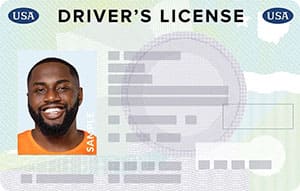- 0 Incorrect (8 allowed to pass)
- 0 Correct
- Updated for February 2025
- Based on official Connecticut Driver's manual
Free Connecticut DMV Permit Practice Test Three 2025
When you are ready to receive your Connecticut learner’s permit or driver’s license, you will need to take a Connecticut DMV knowledge test consisting of 25 multiple-choice questions. To pass, you will need to answer at least 20 questions correctly to achieve a passing score of 80% or better. The test is based on information contained in the 2025 Connecticut Driver’s Manual, and covers topics such as safe driving practices, dangerous driving, licensing laws, road signs and signals, and more. Anyone of any age who has not previously had a driver’s license must get a learner’s permit in order to learn how to drive. You must be a minimum of 16 years of age to receive your Connecticut learner’s permit and then pass a vision test in addition to passing your knowledge test. You must also take a Safe Driving Course, which takes eight hours, before you can upgrade from your learner’s permit to your driver’s license. You should also be aware that knowledge testing is offered by appointment only at certain Connecticut DMV locations, so you will need to make an appointment online before you go. This 40 multiple-choice question Connecticut DMV permit practice test requires the same passing ratio as the real exam, so you must answer at least 32 questions correctly.
- Perfect for learner’s permit, driver’s license, and Senior Refresher Test
- Triple-checked for accuracy
What you need to know

What to expect on the actual CT DMV exam
questions
correct answers to pass
passing score
minimum age to apply
Helpful links
List of questions (classic view)
- Locked wheel skids are usually caused by
- You must keep your windshield wipers in good operating condition because
- The danger areas around trucks and buses where crashes are more likely to occur are called
- Flag persons are often located in highway and street work zones
- What does this sign mean?
- Do not make a U-turn on a curve or near the top of a hill if you cannot be seen by
- This sign indicates
- What is the first rule of a safe and legal turn?
- Stopping on the pavement or shoulder is only allowed
- On an expressway, you can avoid highway hypnosis by
- Don't turn your ignition key to the lock position while your vehicle is in motion because it will cause
- A red light with a green arrow means
- On a roadway with three or more lanes going in the same direction, which lanes usually offer the smoothest flow of traffic?
- At night, you should use your high-beam headlights in all of the following situations EXCEPT
- Which of the following statements about seat belts is FALSE?
- When passing a truck or other large commercial motor vehicle, you must watch out for
- When entering a main road from a private road, a driveway, or an unpaved road, you must
- You are more likely to survive a car crash if you use _________ together.
- A two-headed arrow with one head pointing straight ahead and the other pointing left means that
- To guard against glare from the headlights of a vehicle behind you, use __________ and adjust it before you drive.
- If you plan to turn beyond an intersection, you should
- If you are parallel parked on the right side of the street, you should _________ before pulling out into traffic.
- A vehicle's stopping distance is equal to
- What does this sign indicate?
- If you are being passed by another vehicle, what should you do?
- If someone is following you too closely (tailgating you), you should
- If your vehicle's wheels drift onto the shoulder of the road, you must
- Which of the following statements about highway interchanges is FALSE?
- Flashing arrow panels may be used in work zones to
- When driving on a one-way street with three or more lanes of traffic, you must use
- What is the best way to handle a curve?
- If you double your speed on a highway, your braking distance increases by
- Don't use your horn
- This sign is
- When you approach a flashing yellow light at an intersection, you must
- When you are driving on an expressway, the condition in which you feel that you are going slower than your actual speed is known as
- A sign with black letters or symbols on an orange background is
- What does this sign indicate?
- All work zone signs have
- You are transporting a child passenger. Who is responsible for ensuring that the child is properly restrained?
More resources
- Alabama: Test 1 / Test 2
- Alaska: Test 1 / Test 2
- Arizona: Test 1 / Test 2
- Arkansas: Test 1 / Test 2
- California: Test 1 / Test 2
- Colorado: Test 1 / Test 2
- Connecticut: Test 1 / Test 2
- Delaware: Test 1 / Test 2
- District of Columbia: Test 1 / Test 2
- Florida: Test 1 / Test 2
- Georgia: Test 1 / Test 2
- Hawaii: Test 1 / Test 2
- Idaho: Test 1 / Test 2
- Illinois: Test 1 / Test 2
- Indiana: Test 1 / Test 2
- Iowa: Test 1 / Test 2
- Kansas: Test 1 / Test 2
- Kentucky: Test 1 / Test 2
- Louisiana: Test 1 / Test 2
- Maine: Test 1 / Test 2
- Maryland: Test 1 / Test 2
- Massachusetts: Test 1 / Test 2
- Michigan: Test 1 / Test 2
- Minnesota: Test 1 / Test 2
- Mississippi: Test 1 / Test 2
- Missouri: Test 1 / Test 2
- Montana: Test 1 / Test 2
- Nebraska: Test 1 / Test 2
- Nevada: Test 1 / Test 2
- New Hampshire: Test 1 / Test 2
- New Jersey: Test 1 / Test 2
- New Mexico: Test 1 / Test 2
- New York: Test 1 / Test 2
- North Carolina: Test 1 / Test 2
- North Dakota: Test 1 / Test 2
- Ohio: Test 1 / Test 2
- Oklahoma: Test 1 / Test 2
- Oregon: Test 1 / Test 2
- Pennsylvania: Test 1 / Test 2
- Rhode Island: Test 1 / Test 2
- South Carolina: Test 1 / Test 2
- South Dakota: Test 1 / Test 2
- Tennessee: Test 1 / Test 2
- Texas: Test 1 / Test 2
- Utah: Test 1 / Test 2
- Vermont: Test 1 / Test 2
- Virginia: Test 1 / Test 2
- Washington: Test 1 / Test 2
- West Virginia: Test 1 / Test 2
- Wisconsin: Test 1 / Test 2
- Wyoming: Test 1 / Test 2
Your go-to, trusted source
Experience the Driving-Tests differenceOur commitment to accuracy and quality in our practice tests
Explore our rigorous, multi-tiered verification process that ensures each question mirrors the official manual for unparalleled accuracy.

At Driving-Tests.org, we understand the importance of reliable and accurate practice tests to help you prepare for your DMV exam. That's why we've developed a meticulous process to create and continually update our practice questions, ensuring they reflect the most current driving laws and regulations.
Here's an inside look at how we maintain the highest quality in our practice tests.
Content Creation and Verification Process
- Alignment with Official Manuals:
Every question we develop is based on the most recent version of each state's official driving manual. Our team regularly monitors each state DMV's website for the latest updates to ensure our practice tests are always aligned with the most current information. - Community Feedback Integration:
We leverage feedback from our vast community of users to understand which topics are most frequently tested. This helps us focus on the areas that are most relevant and beneficial for your preparation. - Expert Content Creation:
Our in-house editor, Steven, who has extensive experience in driver education, crafts each question with precision. He conducts a thorough review of each question against the official manuals to ensure accuracy. - Rigorous Review Process:
Once Steven has finalized a set of questions, our team conducts a joint review session. This second level of scrutiny involves content accuracy, proofreading, and fact-checking to eliminate any errors. - User Feedback Mechanism:
After a question goes live on our site, we keep the lines of communication open. Each question features a feedback button, inviting users to report any issues or errors. This continuous feedback loop allows us to address and rectify any concerns promptly. - Responsive Updates:
In line with our commitment to accuracy, we quickly update our practice questions to reflect any changes in the DMV manuals. Additionally, we update the free electronic copy of the state's driver's license manuals on our site, typically within a few days after the DMV publishes them.
Our thorough quality control process ensures that you have access to practice tests that are as accurate and up-to-date as possible. We believe in the power of well-prepared drivers and are dedicated to providing you with the best study tools to help you succeed on your DMV exam.
Unlock Your Best Chance to Pass
Get instant access to 650+ exam-like questions tailored for CT.
See how Premium can help you pass faster, risk-free, with our 97% success rate.
Connecticut questions seen on the real test
Questions specific to your state. Breeze through your exam with the right tools.
97% of Premium users pass the first time
Compare with the average passing rate of just 49%.
Premium users succeed.Trusted by over 1.15 million customers
The only program recommended by DMVs nationwide.





